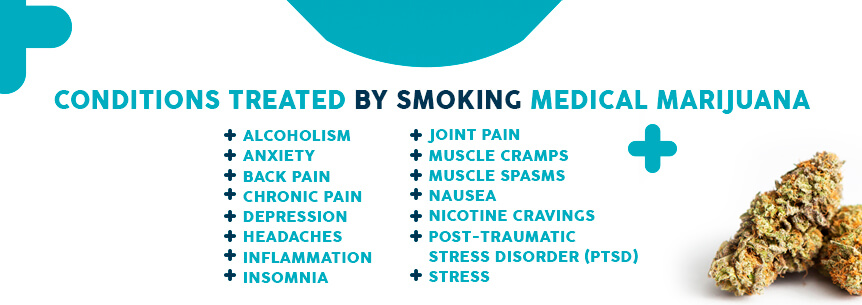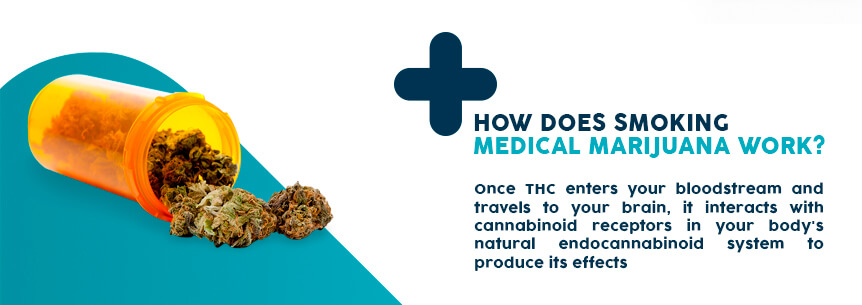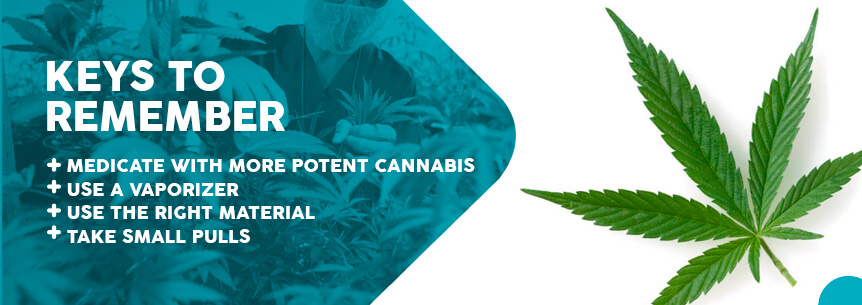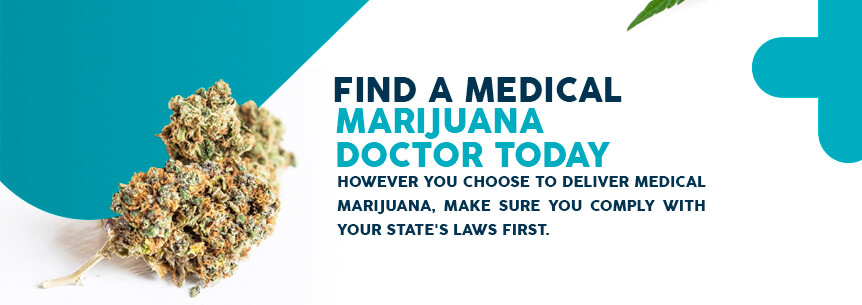
Smoking is the most popular way to ingest marijuana. When patients inhale the smoke from medical marijuana, they experience the effects within moments and have more control over those effects. Patients can choose how much and how often they consume their medicine, unlike other methods which deliver a dose all at once. Smoking medical marijuana may be the ideal method for patients in need of instant pain relief.
However, smoking is not right for everyone. Patients with lung diseases like emphysema or chronic obstructive pulmonary disease (COPD) may want to avoid smoking and opt for a different method of administration, such as taking capsules, tinctures or edibles. Smoking can also irritate the throat for some users.
Nevertheless, smoking weed may not be as dangerous as traditionally believed. For example, according to a 2006 study, there is no link between smoking marijuana and cancer – even in heavy, frequent and long-term marijuana users. According to a 2007 study conducted by Harvard University researchers, marijuana cuts lung cancer tumor growth in half and reduces cancer’s ability to spread. Although more research is needed, inhaling medical marijuana may be the best choice for immediate pain relief. In this post, we’ll share the benefits and risks of smoking cannabis as well as tips for smoking as safely as possible.
Patients may choose to smoke medical cannabis for fast relief of a range of symptoms. Rather than reach for traditional painkillers like prescription opioids, many patients are willing to try marijuana to soothe pain and avoid the risks of opioid medications. The following conditions and symptoms can be treated by smoking medical cannabis:

However, patients with impaired lung functioning should consider other methods of administration to avoid breathing difficulties or irritation. Even though there is not sufficient evidence to prove smoking cannabis has harmful long-term effects, pot smoke can be hard to handle for patients with respiratory issues. For example, patients with the following conditions should avoid smoking marijuana:
Either way, it’s always best to discuss your options with a qualified physician first, because marijuana affects everyone differently. While one patient with anxiety might feel more relaxed after smoking cannabis, another one might feel more anxious. A certified medical marijuana doctor can help determine if smoking is the best method for your condition.
Smoking marijuana produces quick results. This is because when you inhale smoke into your lungs, the psychoactive chemical in marijuana known as tetrahydrocannabinol (THC) quickly enters your bloodstream via the millions of alveoli, or tiny air sacs, lining your lungs. Once THC enters your bloodstream and travels to your brain, it interacts with cannabinoid receptors in your body’s natural endocannabinoid system to produce its effects. As a result, you will feel the relaxing, pain-relieving effects of medical cannabis right away.

When marijuana is inhaled, the THC levels peak within six to 10 minutes. Maximum psychotropic effects occur 20 to 30 minutes after inhalation and last for 45 to 60 minutes or longer. For comparison, it can take anywhere from 30 minutes to 2 hours for patients to feel the effects of marijuana edibles. However, once the edible kicks in, the results can last six hours or longer.
If a patient is suffering from a painful backache, they probably would rather experience relief in a few minutes than wait two hours for the pain to go away. For this type of patient, it makes more sense to smoke medical marijuana rather than eat cannabis-infused food. Likewise, if a patient feels overwhelmed by nausea, smoking marijuana can provide fast relief.
If you are a new medical marijuana patient curious about smoking your medicine, you’re probably wondering how to smoke medical marijuana. To help you make educated decisions, we’ll share some information with you here, starting with the most common smoking tools and what you can expect from each.
Smoking medical marijuana out of a pipe is a simple and inexpensive option for ingestion. It’s also one of the most common ways to smoke marijuana. Many pipes cost less than $20, and you only need to pack them with a small amount of marijuana. To smoke out of a pipe, often made of glass, simply pack the bowl with cannabis, light the bud and inhale.
Some prefer to grind their weed using a grinder before placing the marijuana in the bowl to get a firm pack, although this step is not necessary. You can also use your fingers to break the bud into smaller pieces, but make sure it is not so fine that it will fall through the pipe. It’s up to you how much to put in the bowl. However, many smokers prefer packing the bowl to the top. To avoid burning up all the marijuana at once or breathing in ash, try to apply the flame to a small section of the bud at the edge of the bowl.
There may be a hole or a carburetor, also called a carb, on the left side of the bowl. Keep your thumb over the carb while you light the bowl, inhale a little, and then release your thumb. Pull in the smoke, hold it in your lungs for a second or two and exhale. There is no need to hold the smoke in your lungs as long as possible for the marijuana to work.
Smoking marijuana in a pipe rather than as a cigarette can lead to higher absorption of THC because less smoke is lost, making it a preferred economical choice for some. The downside to smoking out of a bowl is it can be harsh if you take too big of a pull. It’s best to take one small hit at a time until you discover your comfort level.
Water pipes, usually referred to as bongs or bubblers, function similarly to pipes but are shaped differently and contain water. A bubbler, for example, is like a bowl but has a small water chamber attached to it. A bong has an attachment shaped like a bowl, a carb, a base which contains the water chamber and a tube which includes the mouthpiece. Once you light the bowl attachment, the smoke passes through the water chamber and fills the tube for inhalation.
Some prefer smoking out of a bong because the water cools the smoke and provides a smoother, less harsh hit than a pipe or joint. Even so, smoking from a water pipe does not reduce exposure to carcinogens in marijuana smoke.
Some patients prefer to smoke marijuana in the form of a joint, especially if they are trying to give up tobacco cigarettes. A joint typically requires more cannabis than other methods because the cannabis must fill up the rolling paper for it to hold its shape. However, a pack of rolling papers is inexpensive. To smoke a joint, you’ll need to place crushed marijuana buds on top of a sheet of rolling paper and then roll the paper to form the shape of a cigarette.
Smoking a joint may be the least healthy way to smoke marijuana. According to researchers in New Zealand, smoking one joint is equivalent to smoking 20 cigarettes. Marijuana smoke contains harmful carcinogens like carbon monoxide and tar. Also, when patients smoke marijuana from a joint, they run the risk of inhaling too much too deeply, especially if they don’t roll the joint or they pull too hard.
However, marijuana smoke does not contain highly addictive nicotine like tobacco cigarettes. Also, despite the carcinogen exposure, many large-scale studies have failed to find links between marijuana smoking and lung cancer risk. The fact is, anytime you burn a material, whether it be marijuana or tobacco, carcinogens are released from the combustion. Fortunately, there are safer, healthier methods to inhale marijuana.
Using a vaporizer may be the healthiest way to smoke marijuana because a vaporizer does not create toxins associated with combustion. A vaporizer is an electronic device similar to e-cigarettes. When you use a vaporizer, you do not burn the weed, but instead, you heat it to temperatures between 356 F to 392 F to release significant amounts of cannabinoids with few other chemicals. You then inhale a mist rather than smoke.
Vaporizers deliver more THC per gram than smoking because combustion does not occur. For example, research shows that a vaporizer can provide 70 percent THC after vaporizing opposed to a joint which only yields 50 percent.
Several studies show that using a vaporizer is less harmful than other smoking methods. For instance, in one study, vaporizer users listed four advantages of smoking cannabis using a vaporizer instead of other smoking methods. The advantages they listed included perceived health benefits, better taste, no smoke smell and a more significant effect from the same amount of cannabis. Study participants identified only two disadvantages of using a vaporizer – inconvenience and cleaning time.
Another study published in the Harm Reduction Journal asked participants to self-report respiratory symptoms with vaporizer use. This study concluded that vaporizer users were less likely to report respiratory issues than participants who did not use vaporizers, and vaporizer use can decrease the respiratory effects of cannabis such as a cough, phlegm and chest tightness.
The downside to vaporizers is they are more expensive than other smoking tools and can cost as much as hundreds of dollars. Also, although vaporizing is possibly the healthiest way to inhale marijuana to date, more research is needed.
If you are a medical marijuana patient, trying the following strategies will reduce some of the risks involved with the direct inhalation of marijuana smoke:

It’s important to choose a method that works for you and that you feel comfortable with so you can take your marijuana medication as recommended. Always ask a medical professional for advice if you have concerns or questions.
Numerous studies found that smoking cannabis does not harm the lungs, and sometimes even improves lung functioning. For example, a 20-year-long study published in the Journal of the American Medical Association found that smoking cannabis does not lead to long-term loss of lung functioning, unlike tobacco smoking which decreases lung capacity. Pot smokers even experienced a slight increase in lung capacity, according to the study. This may be due to taking deep inhalations of cannabis, rather than the effects of THC and other cannabinoids. A more recent study also found that long-term marijuana does not impair lung functioning.
Patients who are new to medical marijuana may be hesitant to smoke their medication nonetheless. However, they should consider the following benefits of smoking medical cannabis before eliminating it as a possibility, especially if they suffer from chronic pain:
Your experience with smoking cannabis will depend on several factors such as your condition, the type of strain consumed, the amount and the method used. It’s recommended to start at a level you feel comfortable with and start slow until you know what’s right for you. You want to avoid an unnecessarily intense high if you can relieve symptoms with far less.
It’s a good idea to educate yourself and ask as many questions as possible before smoking. Know what to expect and know what you can do to make your experience as healthful and positive as possible. Also, know that some people might experience one or more of the following side effects, while others might not experience any:
Although smoking marijuana is an effective, fast-acting method for relief, it poses certain side effects and risks. Smoking risks include:
Considering that legal medical marijuana is relatively new in the United States, more research is necessary to discover the healthiest ways to consume marijuana and methods to avoid. You might take the following advice from the authors who published a study in the Current Opinion in Pulmonary Medicine – the medical use of marijuana is likely “not harmful to lungs in low cumulative doses.” Nevertheless, your doctor will consider your condition and recommend the best method of administration for you as well as decide if the pros outweigh the cons for your health.

However you choose to deliver medical marijuana, make sure you comply with your state’s laws first. You may need a recommendation from a qualified cannabis doctor to get a medical marijuana card. MarijuanaDoctors.com can help you find a certified physician and a dispensary. We have hundreds of listings covering the country. Use our site to connect with a certified medical marijuana doctor and book an appointment today. To stay on top of the latest medical marijuana news, sign up for our free monthly newsletter.